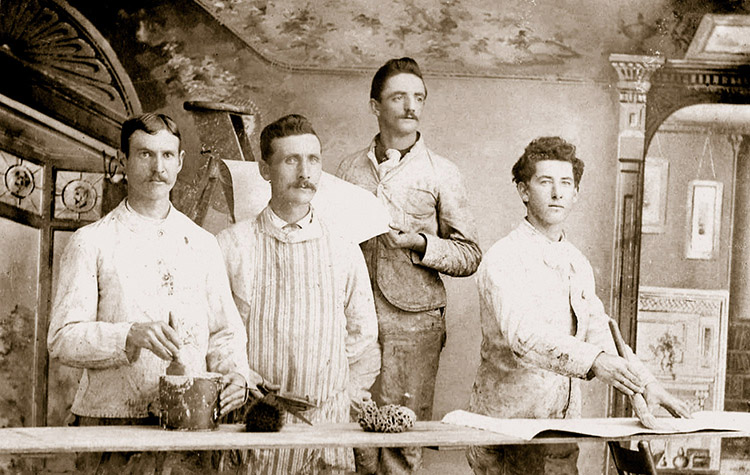Submitted by admin1 on

If you had over 4,000 photos in your collection and someone unexpectedly offered you one more, what would your reaction be? If it was the photo shown above the answer is clearly “WOW - WHAT A GEM!”
What makes this photo so special?
When the Lemp Studio Collection glass negatives were rescued from long-term storage under the eaves at the Lemp Pharmacy in 1977 it was believed that while this was an incredible treasure trove of Tavistock and area history, there were more pictures “out there”. It’s been decades in the coming but this is one of those pictures.
The background tell us that it’s a posed shot taken at a photographer’s studio. Further research tells us that the photographer was J.C. Sutherland who operated a photo gallery on Woodstock Street South. This picture is circa 1894.
All that’s good and interesting but what’s the really big deal? Why the “wow” and “what a gem”?
Almost every studio photo from that era features people in their “Sunday go-to-meeting clothes”. Professional shots of tradesmen in their work clothes, complete with the tools of their trade, are truly rare. This group of wallpaper hangers is one-of-a-kind in the Lemp Studio Collection.
Take a good look at the clothes. You’ll see a work smock, a striped apron and a man in coveralls. When was the last time you saw a tradesman sporting a tie? Check out the paste bucket and large brushes, sponges, smoother, ladder and, of course, the wallpaper. This was a time when almost every room in every house was papered. Think about the challenge of hanging wallpaper not just on the 10 or 12-foot walls but up the staircases and on the ceilings. Yes, the ceilings were papered in days of yore. Scaffolding and dexterity were two necessary elements.
Not convinced yet? Here’s the showstopper. So many of our “people photos” from the late 1800s and early 1900s feature beautifully dressed individuals and families but the names are lost to history. This picture has a name and a story. Bonus!
Second from the left is Fred Eckstein … a man well known, well liked and active in many elements of our community.
Fred has an impressive Tavistock pedigree. His parents were Captain Henry and Susannah (Heyrock) Eckstein. Captain Henry was the founder of Tavistock. Fred was born in 1868; married to Mary Keutsch in 1900; father of Russell, Henry (Ike) and Florence Eckstein; and died in 1922.
Fred lived a full life. His obituary in the Tavistock Gazette tells us that “in his early days he was noted as an athlete of no mean calibre being one of the village’s best hockeyists, footballists and sprinters”. He held the responsible position of Water and Light Commissioner, frequently re-appointed by acclamation. Fred was a valued member of the local fire brigade occupying the position of Lieutenant at the time of his death. Of most interest to this story, the obituary notes that Fred conducted a very successful painting and paperhanging business for 32 years.
Successful? Definitely. Early issues of the Tavistock Gazette were lost to a fire. The first available ad Fred placed in the paper is from 1897. Fred bills himself as a painter and sign-writer along with frescoing (painting on wet plaster), calcimining (applying a white or tinted wash of glue on plaster), paper hanging and more.
Fred and his employees are credited with painting area churches … the Evangelical Church (now Grace) in both the old frame and current brick buildings, Lingelbach Church east of Shakespeare and St. Matthews Lutheran Church on the Maplewood Sideroad. When SS 7 school in South Easthope (Pork Street) was built and ready for paint, Fred had the contract. Signs, storefronts, entire stores, residential work. The list goes on and on. Need a few coats of paint on the water tower tank? Fred’s your man. One particular item stands out. Fred Eckstein and Ezra Kruspe painted the stage curtain for Kalbfleisch’s Hall (later the Opera Hall, now demolished). Newspaper accounts said it was a street scene. In addition to skill, Fred had talent.
Fred Eckstein operated his business out of several locations in the village. The last was Hope Street West. It’s believed Fred’s building (later demolished) was on the site currently labelled 24 Hope Street West. It was a good size, capable of showcasing many of his products and on occasion serving as the local polling station and the setting for the Evangelical Church Ladies Aid tea room and bazaars.
It certainly wasn’t tea and crumpets one day in 1916. Henry McMillan was leading a young heifer to town to be shipped to market when it suddenly became enraged and quite wild. Although having a sack over its head and being led by a leading iron it quickly became impossible for Henry to manage the beast. The cow crashed headfirst into Fred’s wallpaper store running amok amongst the merchandise. It took 8 men to bring the situation into control. Without question, this was Tavistock’s version of the proverbial bull in the china shop.
Time passed without further incident but with yet more business. In 1922, at the age of 54, Fred contracted leukemia and passed away. He is buried with his wife, Mary, on the Grace United Church cemetery.
****
Note: One of the young men in the photo may be Ed Cloney who was known to work for Fred. If you can identify Ed or any of the other men, please tell us.
Reader response February 27, 2020. The man on the far right bears a good resemblance to Milton Loth.